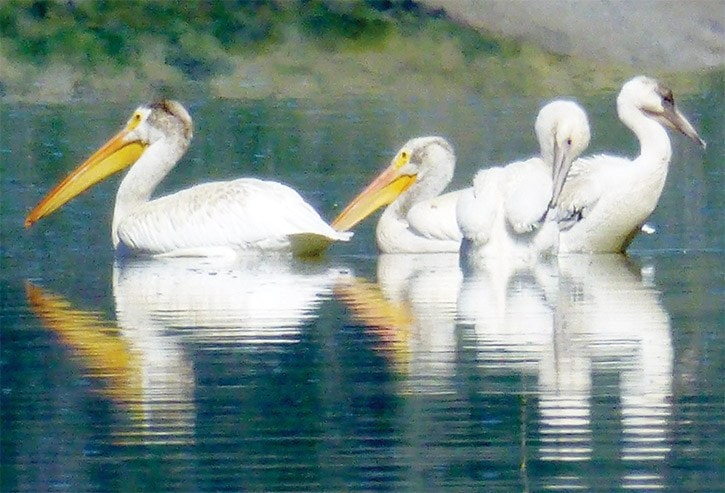A complete nesting failure at the only confirmed White American Pelican breeding lake in B.C. has left local wildlife biologist Julie Steciw extremely disappointed and searching for answers.
“This year I was looking forward and very optimistic that we would have a successful breeding season at Stum Lake,” Steciw said Monday.
Steciw has been monitoring the endangered birds at Stum Lake for Natural Resource Operations since mid-1990 and says a total failure, which occurs when there are no chicks after breeding season, can happen for a number of reasons — human disturbance, wildlife disturbance or low flying aircraft.
She doesn’t know what is responsible this time around.
In May, Steciw and former wildlife biologist Jim Young counted 500 nests at the site.
When they returned in July there should have been a “sea of white” on the islands.
“Usually there are chicks or they have re-nested, but there was nothing,” Steciw confirmed.
Steciw says there was also a total failure during the 2009 season and there have been partial failures ever since.
In 2010 woodchuck burrows were discovered all over the island and Steciw began to wonder if that was the problem.
With the help of conservation officer Ken Owens she successfully trapped the woodchuck in 2012.
“We thought we’d solved the problem of the nesting failures,” Steciw said.
But there is a positive twist in this story. After learning of the nesting failure, Steciw said a local biologist told her she had seen eight pelican nests with two eggs in each one on a small skinny island at Puntzi Lake.
Then confirmation arrived last week of a hatching success when Steciw received a photograph of young pelicans taken by someone who was fishing there.
“With his photo, it confirms those eggs hatched,” she said. “There were three chicks in the photo and a couple adults. It would be pretty interesting if they started nesting elsewhere or were forced to.”
The thought that they can nest successfully elsewhere is exciting, she added.
During her observations, Steciw has learned to appreciate pelicans as “large, gangly and interesting” birds.
“The biology of it is so interesting,” she said. “They are sitting on the nest, trading off and when they come in to trade off, sometimes they come in hundreds at a time. They do a lot of neat vocalization too.”
One of her worries is that unlike Stum Lake, there is no protection for pelicans at Puntzi Lake.
“You aren’t allowed on Stum Lake during breeding season and it’s pretty difficult to get into the area,” she said.
Steciw is asking anyone who observes pelicans to record their name, phone number, the date, number of pelicans, and identify the location with a dot on a Google Earth map if possible, and contact her at Natural Resource Operations, 250-398-4671 or Julie.Steciw@gov.bc.ca.
Government continues to monitor Red-listed species
Breeding records for pelicans at Stum Lake date back to May 1939.
The first census was taken in 1953.
The pelicans normally return to the Cariboo at the end of March or April. If Stum Lake is still frozen, they will visit other lakes to forge for food.
In May they can be seen on local lakes and creeks forging for spawning suckers.
When there is no disturbance to the colony, of the one to four eggs in a nest, on average only .75 fledge per nest.
A banding project several years ago verified the Stum Lake pelicans stay in the western side of the Continental Divide.
They migrate to Washington, Oregon, California and primarily Western Mexico. Three of the band returns were from the left side of the Continental Divide, although that was rare, wildlife biologist Julie Steciw said.
The major migratory route through the province is north through the Okanagan Valley, northwest through Nicola-Thompson, to Stum Lake and the Chilcotin Plateau.
The White American Pelican is Red-listed and designated as endangered in B.C.
